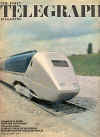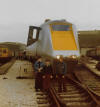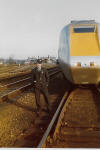 |
The APT-E is pictured here undergoing end-loading tests in the R&DD Test
Hall
Colin Marsden
|
 |
In this shot two of the vehicles are being fitted out as test cars
Colin
Marsden |
 |
One of the driving car bodyshells pictured in the Vehicles Lab
at the RTC when undergoing structural testing in 1971. This part of the RTC is now RVEL's maintenance workshop
Author's collection
|
 |
APT-E undergoing a side pull test in
the Vehicle's Lab during its initial test programme
Peter Keen collection |
 |
APT-E at the Mickleover test track in the early 1970s
Gerald Anthony |
 |
Heading north on the Midland
main line near Loughborough
J A Lower |
 |
The cab layout was designed
around a central seating position.
Author's collection |
 |
PT-E pictured in the Vehicles Lab at
the RTC in the company of one of the power cars of the prototype HST then identified as class 252 001 -
October 1974
Author's Collection
|
 |
APT-E sits on the Goods Road at Derby Station prior to its first run to Duffield, 5 miles to the north,
on July 25th 1972. Photographed from Hulland Street bridge.
Author's collection
|
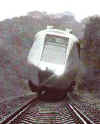 |
A head-on view of APT-E at the
Old Dalby test track in the vicinity
of MP111 at the north end of Grimston Tunnel
Author's collection |
 |
Another shot on the test track. I'm not sure exactly where this was taken
but it may be the southern side of Stanton Tunnel
Cecil J Allen collection |
 |
The articulation between the
vehicles
Author's collection
|
 |
APT-E flashes past MP 111, just north of Grimston Tunnel, on a northbound high
speed test run.
Author's collection |
 |
In June 1974 the APT-E
takes the curve at London Road Junction on its way to Old Dalby.
|

|
'E-Train'
manoeuvres on the loop at the RTC sidings in June 1974 prior to departing
for Old Dalby. |
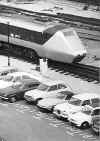 |
APT-E in the sidings at the Railway Technical Centre in 1975 prior to a trip to Old Dalby. The Triumph Spitfire was owned by the author at the time.
|
 |
In this overall view from the top of Brunel House, the APT-E can be seen leaving Derby en route to the test track in June 1974. There's a wealth of detail in the background of this picture - now mostly gone
|
 |
On 27th February 1976, just one month
after attaining nearly 144 mile/h at Old Dalby, APT-E stands at Kettering
Station after a high speed dash down the Midland main line from Derby. The
occasion was a special run from Derby conveying staff from the RTC on a jolly.
|
 |
Later the train was stabled in the Down Goods road awaiting a return path home
On the next road is one of the ubiquitous 16T mineral wagons, which in a lot of people's eyes represented the old railway.
|
 |
Staff from the Railway Technical Centre admire the sleek lines of the
APT-E whilst it waits in Kettering Down platform ready for the return run |
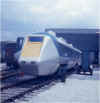 |
Back home in the Research Division yard outside the Test Hall 'E-Train', as it was more commonly known, rests in the sunshine
Mick Wright |
 |
APT-E gets
some attention in the sidings at the RTC in the summer of 1974 between trips to
the test track
|

|
During its trials at Old Dalby 'E-Train' often ran as a three car set
and here it is approaching the EDU as a three car sometime in 1974
Mick
Wright |
 |
Moments later it's past and away towards Trent Junction and on to Old Dalby
Mick Wright |
|
 |
APT-E pictured on the Goods Road at
Derby in September 1974
Ian Walmsley |
 |
In this view of the first
re-furbished MetCam class 101 arriving at the RTC yard in June 1974, the
APT-E can be seen sticking out of the Vehicles Lab workshop. Also in the
shot is part of the 'POP' train, the Baby Deltic 5901, the Battery railcar
'Gemini' and the Elliott 4-wheel Track Recording Car - Lab 20. |
 |
APT-E near Goring on the West of
England main line on 27th July 1975 whilst on a test run
D E Canning |
 |
APT-E passes Steventon on the West
of England main line on 27th July
1975 whilst on a test run
D E Canning |
 |
On 28th October 1975 APT-E is
pictured arriving at St Pancras during a series of test runs on the Midland line
BR Official |
 |
APT-E waiting to depart from St
Pancras for the run back to the RTC
BR Official |
 |
By April 2003 three of the four cars
were languishing in the yard at the National Railway Museum in York. PC1 is on
the left
|
 |
Another
shot of the intermediate car at York in 2003 - they were cosmetically
restored for the '200th Anniversary of Rail' in May 2004 |
 |
On 24th May 2013 the APT-E received
an
IMechE Engineering Heritage Award in recognition of the 13 years of hard graft
which the APT-E Conservation & Support Group had put in to cosmetically restore the
vehicles to something like new. I wonder what state the train would be in
without these guys' efforts
|
 |
The APT-E has also been restored
internally and one vehicle is now equipped with seating The Group is small team of dedicated
volunteers and was formed by Paul Leadley.
Here is the APT-E at the NRM's other
site Locomotion at Shildon, Co Durham in 2013 |
 |
A picture of the other driving car |
 |
Prof Isobel Pollock, past President of IMechE,
presents APT-E Conservation Group founder Paul Leadley with an
Engineering Heritage Award at the NRM Shildon on 24th May 2013
Unknown |

